September 2015 archive
Shoot one – check! Our pre-production paid off as our first shoot ran pretty smoothly. As a whole, we were satisfied with the footage we obtained and got most of what we needed for scenes one and two. But what’s a shoot without a few complications? I’ll delve into the positive and negative outcomes below.
1. Casting
We were stoked to have our three cast members actually show up, arrive on time and be totally dedicated to their performance. Christina’s experience really translated onto the screen, as did her attitude and actions behind the scenes (making suggestions, asking questions etc.). Chris and Scott, although less experienced, certainly put their best foot forward and pleasantly surprised us with their performance. Scott in particular, though struggling at first to remember his lines, captured the essence of Ted perfectly. So a big thanks and well done to our wonderful cast!!



Unfortunately on the day we found out that it was our Christina would not be available for a second shoot. While we were informed a few weeks prior that she would be going away in or week or so, we were under the impression that there may be some time before then that we could catch her. We found out on the day that this wouldn’t be possible, which put is in a bit of a pickle as the second part of our concept revolved around her character, Emily. Forced to re-think things after the shoot, we turned the setback around as we decided to transform the story into a ‘missing-persons-unit’ and have Damien as our new protagonist – Psycho style. I was proud of our efforts to come up with this alternative scenario by working with the limited resources we had.
2. Time
Timing wise, our call sheet was pretty much on the money. In saying that, I was secretly hoping we’d get through it quicker than expected so we could do MORE than what was scheduled. In the event of this rare scenario, I had an array of thriller-esque shots planned, as the scenes we were shooting on the day simply set up the scene. As expected though, we ran out of time and only had time to complete the scenes rather than delving into the more intense, thrilling moments. I acknowledge that setting the scene was our priority on the day however – hence why it was only this that I wrote into the call sheet – so I was satisfied that we were able to get that far. Hopefully we get a chance to hone in on the more thrilling content in our subsequent shoot.
Furthermore, due to time constraints we also needed to prioritise the shots with our cast in them, rather than the scenic establishing shots. Christina was of particular concern as she was no longer available for a second shoot, meaning we had one chance and one chance only to film the shots needed with her. We therefore needed to be selective and choose the shots that were absolutely necessary first, followed by those that were less so. Alex went through the shot list to determine the importance of shots listed to guide the order in which we did things. I suggested we put all the establishing shots to the side, as while they are integral to our film, I volunteered to get them by myself at a later date. In doing so, I must be mindful about weather conditions to ensure they mimic those of our shoot.
3. Conditions
Shooting outside is always a risk – especially in Melbourne! We were fortunate on the day however as we were blessed with the perfect mild temperature and cloudy skies. These were ideal conditions for shooting as a) we were not uncomfortably hot or cold; and b) clouds meant we didn’t have to deal with harsh shadows created by the sun. While wind was an issue at times, it was not excessive and we were able to work around it. It was extremely lucky that we delayed the shoot as the previous Tuesday saw constant rain and hail throughout the day. If we were burdened with poor conditions on the day, I feel like we would’ve had no choice but to cancel. Phew!
Shooting in public spaces also has it’s disadvantages in terms of public interferences. As the walking track along the river is a popular spot for Warrandytians, at times we needed to wait for passers-by and dogs to exit the frame. Luckily it was a fairly quiet day and we shot strategically along a stretch of track which is less frequently used, so the disruptions weren’t overly problematic.
4. Roles
Prior to shooting, we had allocated crew roles as follows:
Alex: Director
Laura: DA
Sarah: Sound op.
Bonnie: Camera op.
On the day however, we ended up chopping and changing a fair bit between roles. While Sarah remained committed to sound, Alex, Bonnie and I switched it up between being director, DA and camera operator. I use the term director loosely however as we all worked together to get the perfect shot – each making suggestions and assuming varied levels of creative control. At times this approach led to conflictions of opinions, but at the end of the day we always prioritised what was most logical as we held the mutual goal of producing a high quality outcome. Communication was key in this situation in order to ensure we were each being fair and just, whilst being mindful not to put anyone down.
5. Name
Oh! An exciting moment of the shoot was coming up with our new title! As we were entering the state park via Tills Dr, Alex noticed a sign that said Black Flat – the actual name of the state park our film would be based in. This was so much more fitting than “The Pines” and it conveniently sounded quite dark and mysterious, in line with our film’s concept. Yay for productive coincidences!

Overall, I was very happy with how this shoot went down. We worked well as a team and exerted a degree of professionalism through our engagements with cast and our ability to work under pressure. We relied heavily on our carefully prepared pre-production documents, which effectively allowed for maximum efficiency. For my first formal shoot for a narrative piece of work, I felt as though we collectively had a strong grasp on what we needed to do and how to do it with relative success. Our experience on set certainly will serve as a valuable learning experience for future projects down the track. Hands in, go team!
Pre-production, pre-production and more pre-production! Squadron has been working hard on a number of documents to ensure maximise productivity come shooting day.
First of all, is of course our script for scenes one and two, which I must give credit to Jackson for writing and Alex for editing. This was written a few weeks ago (yet haven’t got around to posting it on here) and we have devised most of our pre-production planning on its basis. It was really fascinating to see exactly what Jackson did with my original concept and how he brought the characters to life. I feel like this could’ve gone either very wrong or very well– fortunately I felt he did my concept justice by staying true to the prose but developing and adjusting it the necessary amount.


See full version of the script for scenes one and two click here.
I took it upon myself to make the call sheet as I wanted to be able to give our cast and crew as much notice as possible in regards to our game plan on the day. It was important that we dedicate enough time to each location to ensure we would be able to attain what we needed within each. Conveniently, our scenes were about the same in terms of length and shot numbers, which made it easier to allocate time. With scene one, we have a bit of flexibility in that we can eat into lunch time if need be, but with scene two however we must wrap by 3pm at the absolute latest to ensure we can get the equipment back to uni in time. It will be interesting to see on the day how much we follow the call sheet. In the process, we will find out what stages are the most time consuming, where we need to focus more time and less time, etc, and keep this in mind when approaching our next shoot. A call sheet is also essential whilst on set for its inclusion of details such as nearest police and hospital. If anything was to go wrong, we have that information on hand so that we can deal with the situation appropriately.

Sarah completed a storyboard for our shoot, as pictured below. I think it really helps to visualise the shots we intend to capture before the shoot as it enables us to know exactly what we’re doing going into the shoot. It also allows the opportunity to put our creativity on paper prior to the shoot, as sometimes in the rush of it all we might not think as clearly or creatively as we usually would.
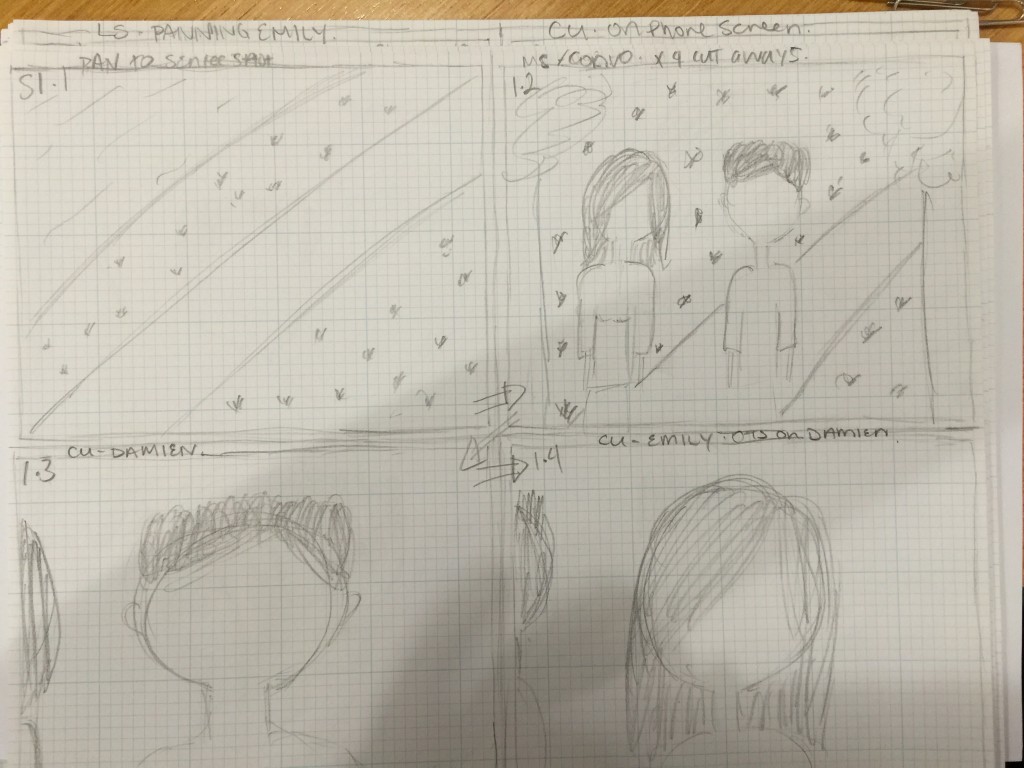
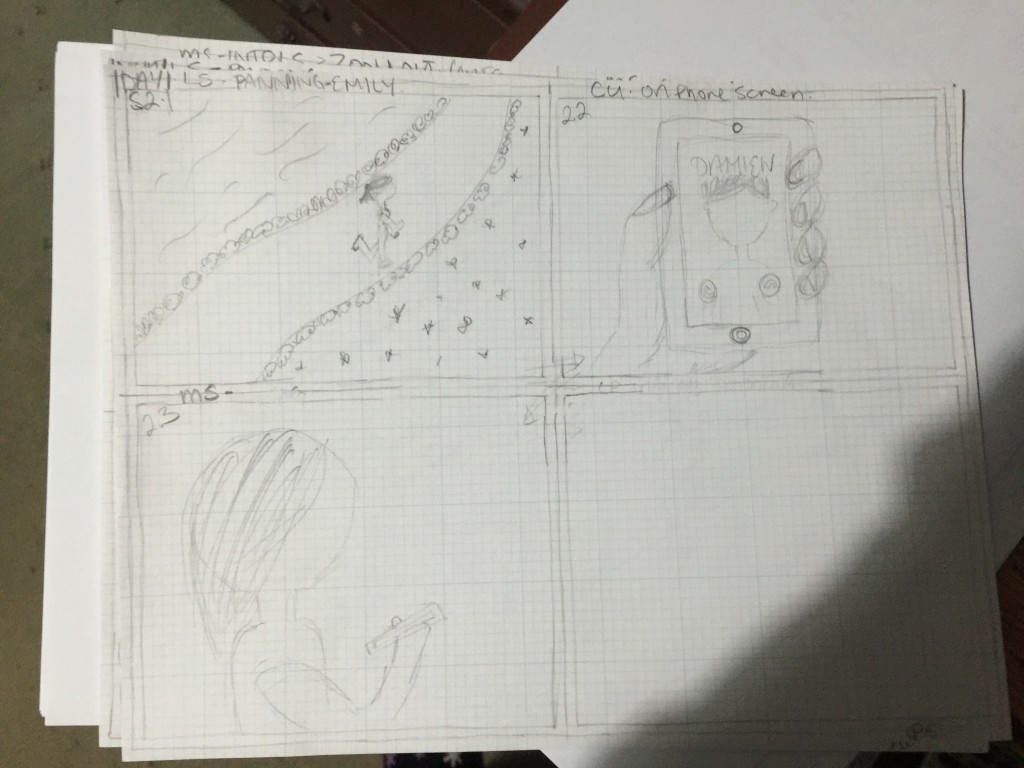

See full story board images in our shared google folder by clicking here.
To complement the storyboard, I devised a comprehensive shot list in line with the shots Sarah had planned, as well as with some additional shots that I envisioned. I think the shot list will be particularly useful as it collates all our shot ideas into one concise document. The inclusion of the ‘Done’ column will make it much easier to assess the footage, as we will know exactly what we are dealing with by looking at the shot list alone. To make this process work, we must ensure that the shot numbers on the list line up with what we write on the slate. I think it will also be worthwhile to note on this document which take was perhaps the best so it can be easily retrieved in post-production.


See full shot list by clicking here.
Finally, Bonnie compiled a number of images for the different props and costumes required for the shoot. I sent this forward to our Chris and Scott so they could use it as a reference point.

Come the shoot, it will be interesting to see which documents we rely upon the most. This will in turn guide our practice for the subsequent shoot as it will inform what pre-production documents we should prioritise.
In Thursday’s class, Paul took us through advanced sound and camera ft. the audio mixer kit and the Sony Z7. While I like to think I’m pretty savvy when it comes to technology, I was totally overwhelmed by this session because a) neither myself or my group members were familiar with these pieces of equipment; b) we were shooting on Tuesday; and c) it was so bulky and heavy for us to take all the way to Warrandyte via public transport.
We had to think logistically about what equipment would make the most sense for our project and our capabilities. We deemed that the Z7 was simply too unfamiliar and we didn’t want to risk using a piece of foreign equipment where it counts. If we had been using this equipment from the start of the semester then we’d undoubtedly be more confident, but it was just a bit too far of a stretch. Also, as we intend to get a number of handheld shots, this camera was a bit too heavy for our uses. With that in mind we decided we would be more comfortable using Sony MC50.
Sound recording devices was our next predicament. Our options were:
- Record and monitor the sound with a zoom H4n, connected to a shot gun mic and boom pole
- Record onto the zoom and use the audio mixer to monitor sound, connected to a shot gun mic with a boom pole.
After class we decided to test these two measures whilst filming with the MC50, upload the sound and practice synching with the visual. While Paul was adamant that we use the audio mixers to best monitor our sounds, we were apprehensive about this device as we did not have a thorough understanding of its operation. Upon testing it, I was nearly deafened and gave myself a neck spasm (buttons were pressed the mixer let off this horribly loud tone – I was the lucky one to be wearing the headphones) and our sound pickup was terrible… I understand that if we had used it properly then this wouldn’t have been the case, but that was exactly the problem – we didn’t know how to use it properly. I was much more familiar with the H4N, and although I’m not even the sound operator in our shoot, I knew that it would be a much wiser to go with option one.
With that in mind, we recorded a brief ‘interview’ on the camera and with our chosen sound recording set up. I wanted to make sure we could successfully and easily sync these in Premiere as after the shoot we would have masses of files to deal with. We eventually figured out the syncing process and I created a clip comparing the built-in camera mic to the external source sound recorded on the H4N. It was necessary that I evened out the volumes of each recording device as the camera sound was very loud in comparison to the zoom (must’ve been on a low gain). Here’s the result – props to Michael for being our impromptu host:
From this, you can note the drastic difference in sound quality between the camera (first clip – lots of background noise, echoey dialogue) and the sound recorded separately and synced in post (second clip – much clearer, crisper sound and significantly less background noise). We were satisfied with the sound acquired on the H4N and thus felt this would be adequate for our production. For this particular assignment, we are less concerned about sound and image quality and more focused on translating our script to the screen. Don’t get me wrong, I know it’s sound and image quality is important, but for the purpose of our production we were happy to settle for second best so we could really focus on story, composition and continuity.
Later on down the track I would love to do a shoot with all the equipment Paul presented to us to maximise sound and vision quality, but for this particular shoot, it was just not meant to be.
In a group meeting in week 8, we came up with the following game plan for shooting times. Unfortunately due to conflicting schedules of group members however, not all of us are able to be there on each day:
- Week 9 Tuesday – Sarah, Alex, Laura and Bonnie
- Week 10 Tuesday – Sarah, Alex, Laura and Bonnie
- Week 10 Wednesday – Sarah, Alex and Laura
Alex was adamant that we could shoot our script without casting the supporting characters to avoid the hassle. Obviously we had Christina, her housemate and qualified actress, confirmed as Emily, but it was the other two who were seemingly harder to place. Alex suggested we work around it by having Emily speak on the phone, instead of walking along the river with Damien, and have her come across a mysterious faceless character in place of Ted (i.e. one of us dressed up in a coat and hat…). We temporarily agreed on this concept, however I was concerned that we would be creatively limited for shots, and experience difficulty in building dynamic relationships on screen. Upon speaking to Jackson I discovered that he shared my viewpoint, and given that we were very unprepared the day before shooting, I sent my group the following message:

To my relief, the group saw the logic in my proposal and with that, the plan took a new turn. We talked to Stayci about our new intentions in our consultation and she gratified our approach. So within the week, I now had the challenge of finding two cast members, Sarah and I would refine the pre-production documents (storyboards, shot lists and call sheet) and Bonnie would organise costume and props. This was definitely the right decision to make as we were nowhere near prepared enough to shoot the next day.
In terms of casting, I figured it would make the most sense to cast locally because 1) people would be more likely to agree if they have do not have to travel far; and 2) they would already have a relationship with the setting, which is an integral component of our production. While StarNow presented a number experienced actors apparently willing to work with us, my group and I were concerned about their reliability and whether or not they would be willing to make the trip out to Warrandyte. With that ruled out, I had a few people in mind who I thought might be up for it, but the most difficult part would be to find people who were available during the day on a Tuesday. Nevertheless, let the hunt begin! I asked a friend of mine who is involved in the Warrandyte Theatre Company if he knew anyone who would be willing, a friend from school involved in the theatre at high school, my next door neighbour who has a very bold and extraverted personality… But no luck! With a bit more persistence however, I casted the ideal Damien and Ted:

Meet Damien, who’s actually my friend Chris from high school. Chris hasn’t had any acting experience but was happy to help out a friend and keen to try something new.

Meet Ted, who’s actually my boss/editor at the Warrandyte Diary newspaper, Scott. He’s been in a couple of advertisements and is used to putting himself out there due to his field of work. He was keen to get involved and was excited to play such a different, albeit slightly creepy, role.
It will be interesting to see how it all goes down with one experienced actress, being Christina, and two amateur actors, being Chris and Scott. Will their exchanges come across naturally or will one out-perform the other? Given their experience we will also likely have to work differently with each actor in terms of guidance and instruction. It helps that I have a personal relationship with both Chris and Scott so they will likely feel comfortable asking me any questions or queries, and vice versa.
On Thursday we will be doing advanced sound/camera and group work. I think we must utilise the time all together to ensure we are on track for our upcoming shoot.
After a slightly overwhelming yet necessary run down of sound recording, we set out to do some filming in the Carlton Gardens to prepare for our upcoming shoot. Due to poor weather conditions however, we could not get as much footage as we originally intended.
Nevertheless, we practiced some handheld camera movements to follow a moving subject in between patches of rain. It’s impossible to get these types of tracking shots without camera shake, but due to the thriller/horror nature of our production, a controlled amount of camera shake contributes to the style and tone of the film. For example, when following a character from behind, camera shake suggests someone is following them. We just need to control the level of camera shake – if too much it will detract from the vision on screen, if too little it will not create the desired mood.
Despite minimal footage, I was still keen to make something out of it that would be relevant to our project. I decided to have a bit of fun and change the focus of my editing to ‘how music changes mood.’ Here’s what I came up with:
As you can probably tell, I began by finding dark and eerie royalty free music to accompany the shots in order to establish a mood of suspense and tension. This is likely the approach we will take when editing our final product, so logically it was something I wanted to explore by gauging an understanding of what sort of royalty music of this style is out there. Keen to experiment and create something fun, I was interested to see how other styles of music would change the shots at hand. I found some tracks on the other end of the spectrum (genre wise) to create a dramatic contrast and totally transform the mood from one extreme to the other. By making the comparison between the same shot but with different music, viewers are led to acknowledge how music changes mood.
From this task, it became clear just how much music can influence a scene and viewers’ perception of events. Everyone reads shots differently in terms of its stylistic and symbolic qualities, but music almost speaks a universal language. For example, every viewer has the potential to identify dark, suspenseful music and make the association between the sound and vision. In fact, this association process is very much subconscious. We don’t consciously think to ourselves “ooh scary music is playing now, that must mean something bad is going to happen.” Instead we consume the product as a whole, subconsciously take in the music and vision as one, and rely on our embedded familiarity with the musical style to have effect over our emotional understanding of the shot. I think when we consume media music and sounds in general often go over our heads and fly ‘unnoticed,’ but by doing exercises such as this, you come to realise just how important and influential they really are.
Today we had our first consult with Paul after the presentation. To be honest, it was a bit of a reality check as the realisation hit that we really need to knuckle down and get moving with our final outcome. Prior to this meeting, most of our attention was focused on the presentation alone, and now we’re in a position where we need to actually put our words into action. It’s easy enough to say what we intend to do, but doing it is a whole new matter!
Paul began by encouraging us to come up with a name, or at least some form of working title. I think name’s are really difficult to commit to as it is such an important part of your product. People’s first impression of a media product is usually based on the name, and that can influence whether or not they choose to engage with it. Of course concept is important, but viewers may not seek out additional information unless they are intrigued by the title… I think this is kind of why we’ve avoided naming it all together. In our consult I casually said that I’d pick my group up from The Pines, a shopping centre nearby which is on the bus route. And with that, The Pines became our working title. Emphasis on the word ‘working,’ as unfortunately there are no pine trees in the Warrandyte State Park. “The Gums” would be more accurate, but that suggests some sort of dentistry nightmare – not exactly the horror vibe we’re going for.
We also discussed permissions, call sheets and safety reports. As the primary location manager (if that’s even a thing), I took it upon myself to handle permissions. Thinking it’d be fairly straight forward, I sent the following email to Parks Victoria:
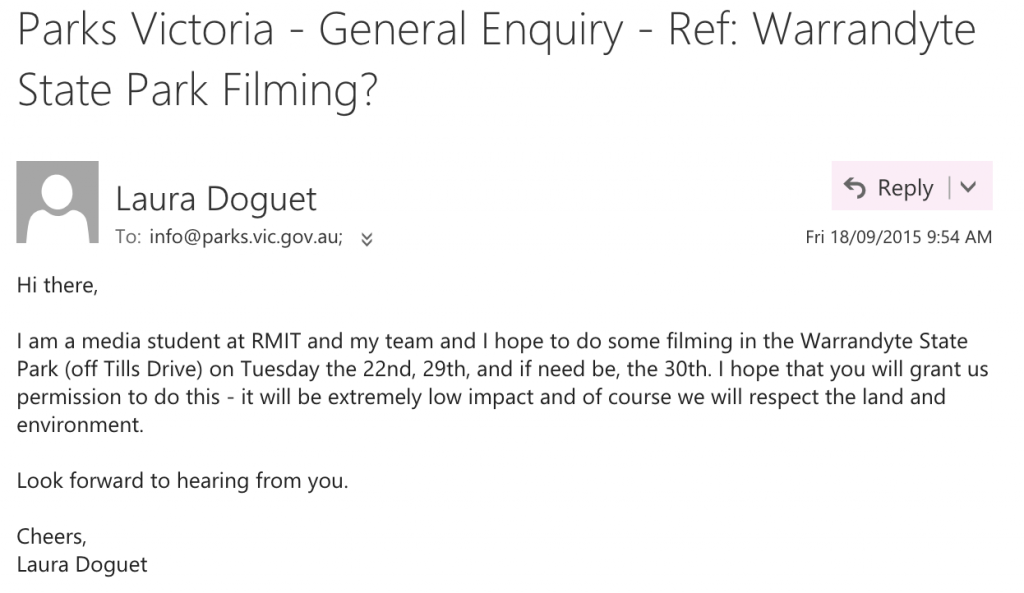 Only to get the following reply:
Only to get the following reply:
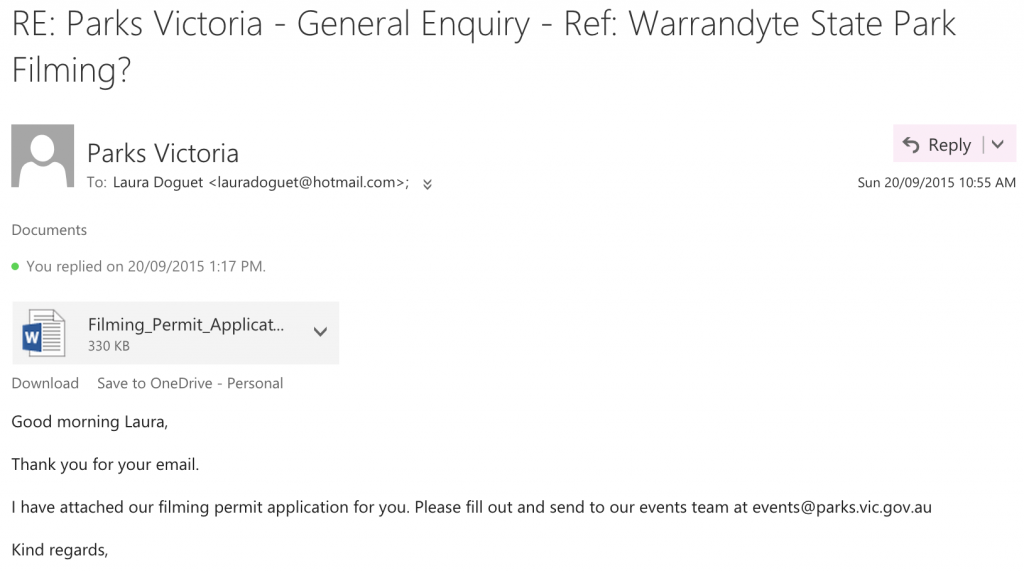 The document attached was an filming permit application form which was 17 PAGES LONG. On first thought, I figured there was no way this is going to get approved in time even if I do fill it out. However, upon reading the document a bit closer I’m 90% sure that the need for permit doesn’t apply to us. To my understanding, it is for commercial projects, whereas our filming is primarily for personal use. THANK GOD. This goes to show why full-scale, commercial productions require so much more time. If we were shooting a feature film and required permission for say six locations, it would likely take months to coordinate.
The document attached was an filming permit application form which was 17 PAGES LONG. On first thought, I figured there was no way this is going to get approved in time even if I do fill it out. However, upon reading the document a bit closer I’m 90% sure that the need for permit doesn’t apply to us. To my understanding, it is for commercial projects, whereas our filming is primarily for personal use. THANK GOD. This goes to show why full-scale, commercial productions require so much more time. If we were shooting a feature film and required permission for say six locations, it would likely take months to coordinate.
In Thursday’s class, we intend to experiment with shooting walking and running shots as they can be quite difficult to perfect. Further actions from this point forward include the allocation of roles, selection of shooting days, and undertaking the necessary pre-production steps to maximise our productivity.
The following are the slides we used for our presentation on Thursday. I acknowledge that some of them won’t make sense without the context of what we were saying, so I will explain what each member was exploring below.
Sarah introduced our project by outlining the genre we intend to investigate, what we will produce and what roles and research we will each be undertaking.
Bonnie followed by identifying some films and trailers which we have used as inspiration. She compiled them into a short video with voice over analysis, listing the techniques and elements we appreciate and hope to mimic in our production.
I was up next and talked about Warrandyte as a location, how we established our idea with the location in mind and divulged our findings from location scouting the other week (what I said can be found in one of my previous blogs).
In classic Jackson style, he humorously shared how he has found the script writing process so far, as well as what our story concept is actually about.
Finally, Alex talked about the script editing process. She identified her intentions when going through the script, such as identifying things that could be more concise or parts that could be improved, and identifying parts that are unnecessary.
Overall, I think our presentation went quite well as we each had a clear idea of our roles and what to discuss. We were given confidence in our consultation with Stayci who was supportive of what we intended to convey. In our feedback, Paul acknowledged the fact that shooting for a trailer specifically could be interesting as it challenges the conventional practice (in which the film is made first, the trailer second). Although this had crossed our minds originally, we thought we might be limited creatively and restricted by a format if we decided to shoot for a trailer alone. Hence, we decided we would be better off to direct most of our attention towards producing a sequence of quality scenes, and if suitable, construct them into a ‘trailer-type format.’ This prototype will exhibit the highlights of the scenes and act as a teaser for the complete ‘feature film.’
Although I am interested to explore the thriller genre further, I did like the sound of the other groups’ intentions to experiment with different genres and characters in their productions. Interestingly, many groups assumed this same sort of approach. I really liked the premise of these ideas but did question their achievability given time constraints. I suppose the specificity of ours will allow us to really hone in on what makes a good thriller and hopefully produce something of a high standard.
I hope our presentation fuelled some excited for what is to come from Squadron. I’m looking forward to the weeks of hard work ahead and to put our words into action (literally).
Thriller Final from Bonnie Dunleavy on Vimeo.
Embedded above is the Bonnie’s moving mood board/trailer compilation that we will exhibit in our presentation. I must give full credit to her for the voiceover analysis, but I thought in this blog I’d expand on her thoughts with my own observations.
It’s interesting to note the similarities in the relationship between the location, character and camera in these trailers/films. In a sense, the location becomes a character as it plays a role in the protagonist’s growth and development. For example, the environment of the Hunger Games presents challenges that Catniss must overcome in order to become stronger as a character.
In each trailer included, there is this frequent sense or urgency and panic when surrounded by nature. An interesting motif across all trailers is the action of running frantically through the forest, suggestive of its dangers and unpredictability. While of course there is presumably a more immediate danger that they are running from, i.e. the villain, the bushland certainly does not make this chase any easier for the protagonist. We all know that scene where the protagonist trips over a log and scrambles around on the ground as they attempt to get up. Cliché yes, but a clear example of how a bush/forest location can be used to exacerbate the danger that already exists.
To translate the sense or urgency and danger onto the screen, certain shots and camera movements are utilised. In the more intense forest scenes, the camera follows them as they run with an extremely shakey tracking shot. It can feel as though the viewer is running behind them and thus can relate to their fear on a more intimate level. If wider more stagnant shots are used, the mood is usually calmer.
I think it’ll be interesting to figure out how to best encapsulate Emily’s (our protagonist) fear through camera techniques and her relationship with the location. If we decide to include the stereotypical running scenes through the bush, we would definitely need to experiment with shots to see what we can actually achieve without any elaborate equipment. It will be a fun challenge to play with camera angles, shots and movements to assess what will best create our desired mood.
The following post is my part of our presentation:
Our final project concept was largely inspired by our chosen location. In our first brainstorm as a group, we went around the circle and each shared where we lived as it made sense to us to film with an area that a group member was familiar with. From weighing up the visual appeal of locations to the logistics of shooting within them, we came to the conclusion of filming in my hometown, Warrandyte.
Warrandyte is a small north-eastern suburb about 50 minutes from the CBD. The town and environment remains preserved with beautiful state parks, vast bushland and serene spots along the Yarra River. If need be, we also have access to a house for interior shots, as well as cafes and supermarkets that I’m affiliated with.
While on one hand Warrandyte can represent peacefulness and serenity, on the other it can be perceived as the complete opposite. With the bush in mind, we were led to consider thriller/horror genres as there is this frequent association with bushland and the harsh Australian outback with these sorts of themes. Thus, instead of writing with an actor in mind like the activity we completed in class, our intent instead became to write and create with a location in mind. We found that this process made the task of coming up with a story and concept much easier as we already had something to work with and draw from.
Once we had decided on a rough story concept, Bonnie and I actually went location scouting. We were on the hunt for two key locations – one for our ‘calm before the storm,’ semi-romantic scene, and the other for our creepy, thriller-esque bush scenes.
Location one – the main walking track along the Yarra River
The main walking track along the Yarra was an obvious choice to check out. In one of our scenes, which Jackson and Alex will explain further, our female protagonist Emily walks along the river with her fiancé Damien. As I wrote the concept for this scene thinking of this specific location, it fitted the scene seamlessly. The only issue we may encounter with this spot is that it can get quite busy on weekends and nice days.



Location two – Pound Bend
Pound Bend is another scenic spot in Warrandyte which features the iconic gushing tunnel. It’s a really cool location but is almost too much for our calm scenes as it may detract visually and aurally from the conversation between our characters. If we wanted to be a bit experimental however, we could get some shots of the water gushing through the tunnel to intercut with some of the later, more intense, bush scenes.
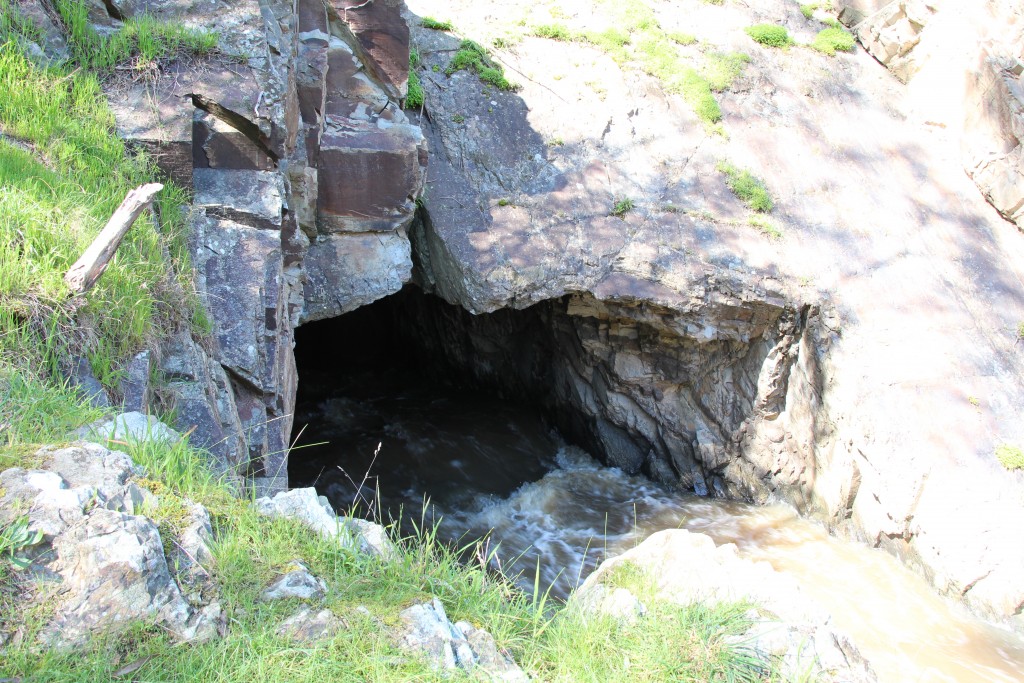

Location three – State Park via Whipstick Gully
This state park was home to some interesting relics of the gold mine period, such as this mine and this big ol’ wall. However, as this state park is commonly used by bushwalkers and horse riders alike, it has very defined and obvious tracks. This is an issue as we want the bush location to appear isolated and remote – not something people use on the daily. It was also a bit too green and welcoming for our liking.
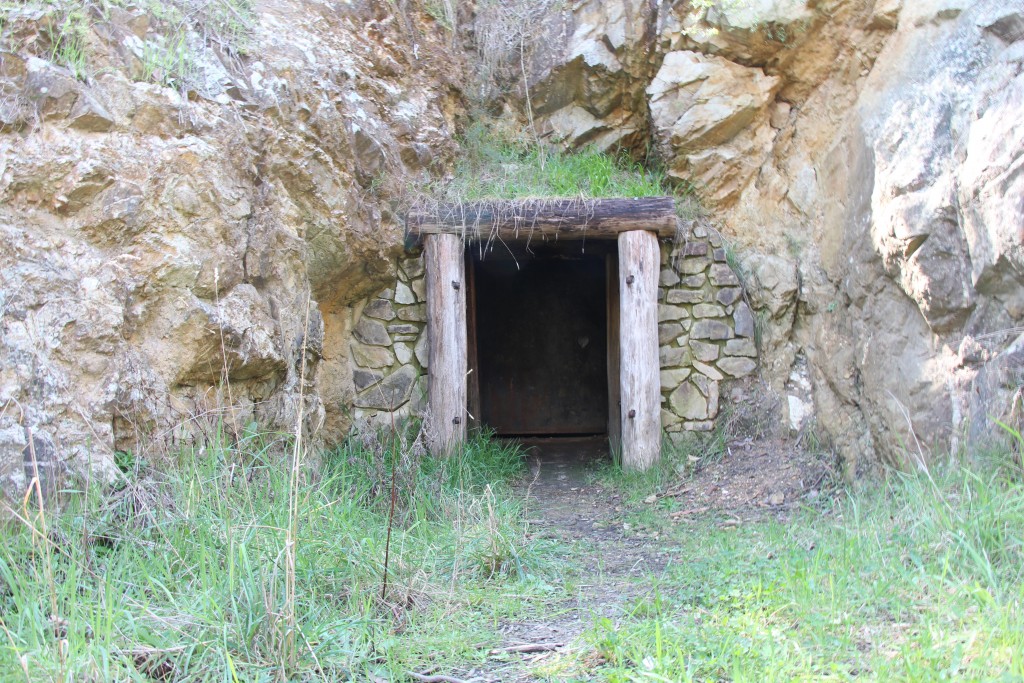

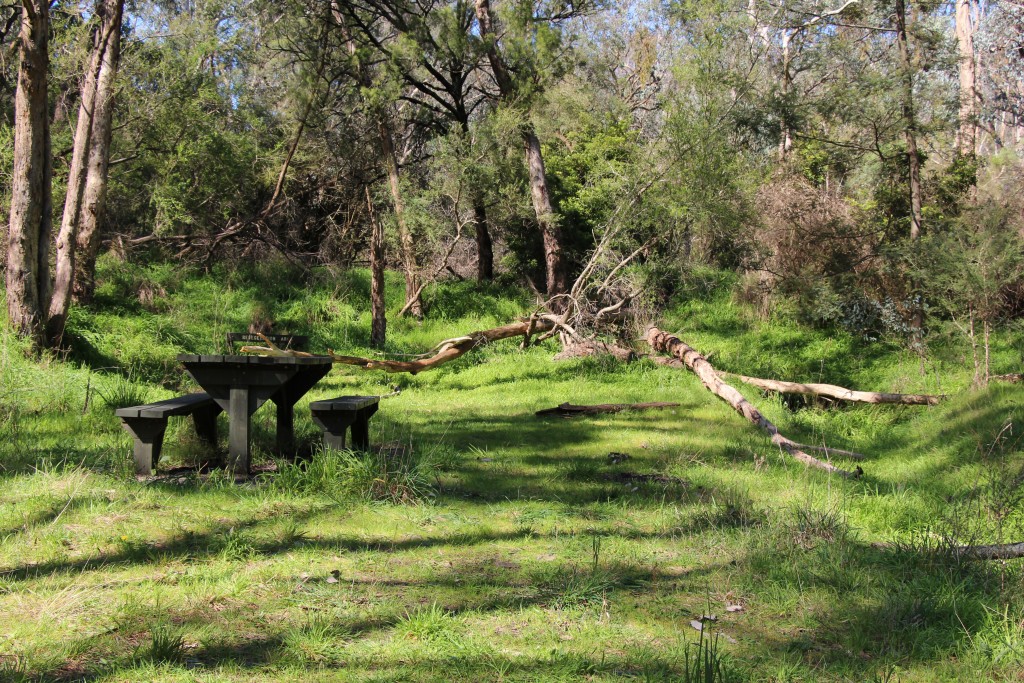

Location four – State Park via Tills Drive
The final state park we went to was a clear winner for our bush scenes. We discovered these bizarre sink holes containing rusting rubbish surrounded by the dry bushland of the park. The creepy and eerie vibe was just what we were looking for, and there was also potential to veer away from the track to set the scene within a more desolate-appearing area.

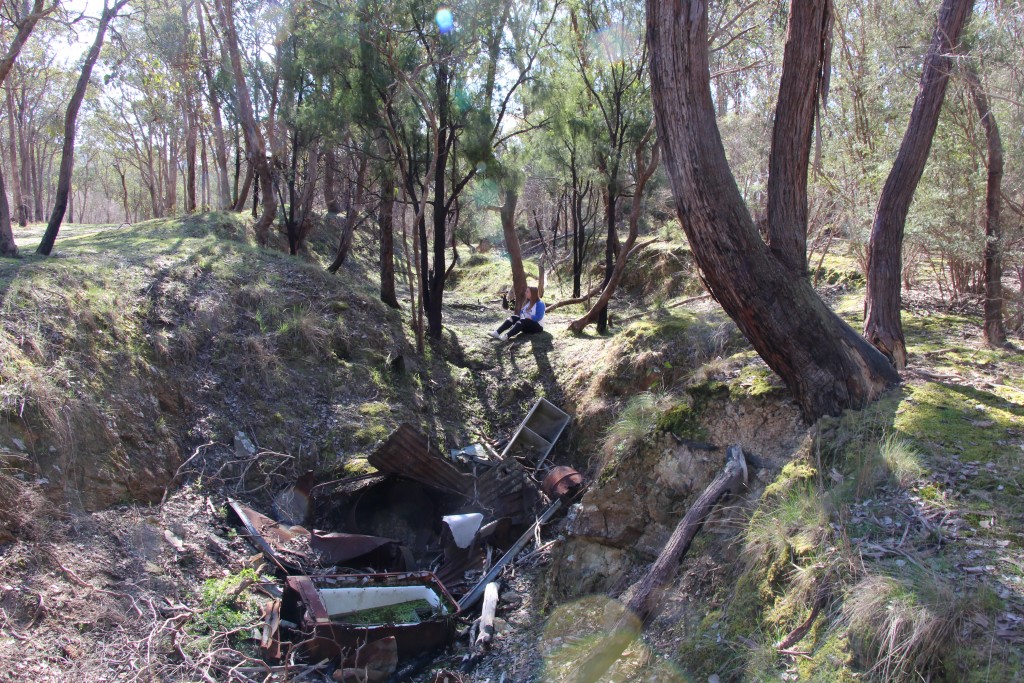

After all writing and discussing our proposed ideas for the final project, we decided as a group to go forth with my concept, as it seemed to be the most workable and appropriate for the nature of the task. We then loosely delegated roles based on our interests as follows:
- Sarah – producer
- Bonnie and Laura – location scouts, cameraperson(s) and editing team
- Jackson and Alex – scriptwriters
For the meantime however, we must direct our focus on the fast-approaching presentation in week seven. To my understanding, the presentation is less of a pitch but more of an explanation of our intentions and progress so far. Once more, we allocated each group member with a subject to speak about:
- Sarah – proposal/question, concept, general research
- Bonnie – Trailers to draw inspiration from
- Laura – Location
- Jackson and Alex – Draft script
As above, my main topic of focus is on location, but I will save that for another post. In this blog I wish to focus on the broader complex ideas we will explore through our productions, and thus address in our presentation.
At the crux of our project is the desire to produce something technically sound, visually aesthetic, and most importantly, something with a strong and compelling storyline. We intend to take this a step further however by researching the thriller genre as a whole, investigating what makes a thriller ‘thrill,’ if you will. My concern with the thriller genre is if it is not done well, it can come across as a little cheesy and even comedic. We thus intend to then put our research findings into practice in our writing and filmmaking.
So a good starting point is to investigate what exactly defines a thriller.
I found the following definition online which I thought summed it up quite well:
 This definition is a good reference point for our production. It explains what mood we are trying to create, as well as how we want the audience to feel. But through what measures can we achieve this?
This definition is a good reference point for our production. It explains what mood we are trying to create, as well as how we want the audience to feel. But through what measures can we achieve this?
A good story and motivated protagonist are obvious features to a thriller (and any other film, for that matter), but the genre relies heavily on a number of other elements to contribute to its suspenseful nature. According to Bordwell and Thompson, “the thrillers emphasis on suspense and surprise encourages the filmmaker to mislead the audience, and this invites experiments with the narrative form.” This textual quality makes a lot of sense, as if the viewer is fully informed at all times, they will never experience the uncertainty and anticipation of the thriller genre.
To achieve this, certain stylistic choices are exploited in this genre. For example, framing, specifically the use of off-screen space, is utilised particularly well in thriller and horror films. Viewers are led to acknowledge that what they see in frame does not contain the entire world of the story, and that something may be lingering outside of the frame. Filmmakers can create suspense by teasing the viewer with the possibility of something being there (or not).
Music is another crucial element that works to build suspense. When you watch a thriller film on mute, it is not nearly as tense as it is with volume. Music works to subconsciously make us anxious, build our anticipation, excitement, or fear. It is therefore crucial we use music to our advantage to achieve our desired mood and tone.
I believe it is important that we direct significant attention to these stylistic choices in order to better our chance of a consistent, compelling thriller. Hopefully we are able to execute them with success as to avoid our scenes becoming a comedy!































